Investigation of Anti-Friction Properties of MoS2 and SiO2 Nanolubricants Based on the Friction Pairs of Inconel 718 Superalloy and YG6 Carbide
Abstract
1. Introduction
2. Material and Methodology
2.1. Preparation of Nanolubricants
2.2. Viscosity and Wettability Test of Nanolubricants
2.3. Tribological Tests and Conditions
3. Results and Discussion
3.1. Viscosity and Wettability of Nanolubricants
3.1.1. Viscosity
3.1.2. Wettability
- (1)
- The contact angles of the MoS2 nanolubricants were smaller than that of the base fluid and decreased gradually with the increase in the additive percentage. This phenomenon indicates that the MoS2 nanolubricants can easily form an adsorption film on the surface of the Inconel 718 superalloy. Moreover, the higher the additive percentage within the test range is, the better the wettability is.
- (2)
- With the increase in the additive percentage, the contact angles of the SiO2 nanolubricants presented a completely different variation rule. The contact angle of the 5 wt% SiO2 nanolubricant is smaller than that of the base fluid, while that of the 10 wt% SiO2 nanolubricant was 67.81°, which is much larger than that of the base fluid. With the further increase in the additive percentage, the droplets displayed an irregular shape on the sample surface due to poor fluidity, making it impossible to measure the contact angle. This phenomenon shows that the SiO2 nanolubricants cannot easily form an adsorption film on the surface of the lower specimen, and their wettability becomes bad and can even be lost as the additive percentage increases.
3.2. Anti-Friction Properties of Different Lubricants
3.2.1. Friction Coefficient
Base Fluid
- (1)
- In the initial stage, the mean friction coefficient was lowest, approximately 0.052, and the abrasion surface was relatively smooth. In this case, the friction type should be boundary friction, and a stable lubricating film should exist at the friction interface.
- (2)
- In the middle stage, the instantaneous friction coefficient increased sharply and reached 0.178, then showed a slow downward trend. At the same time, some furrows appeared on the abrasion surface. It can be inferred that serious adhesive and abrasive wear happened on the surface of the Inconel 718 specimen, and the friction type should be mixed friction where dry friction and boundary friction coexist. However, the appearance of furrows reduced the contact area of two specimens and increased the unit contact pressure. As a result, the furrows were gradually smoothed out with the rise of friction time, resulting in a gradual decrease in the instantaneous friction coefficient.
- (3)
- In the last stage, the abrasion surface quality was significantly improved, and the frictional process once again exhibited the characteristics of boundary friction; thus, the instantaneous friction coefficient showed a stable fluctuation trend. However, due to the damaged frictional surface, the mean friction coefficient in this stage was 0.0587, which is bigger than that in the initial stage.
Nanolubricants
- (1)
- Figure 9a indicates that, with the increase in the test time, the friction coefficient under the MoS2 nanolubricants exhibited a two-stage change trend that is different from that of the base fluid. In the first stage, the friction coefficient increased first and then decreased. In the second stage, a “low amplitude stable fluctuation” feature was observed. In the first stage, the maximum friction coefficients corresponding to the MoS2 nanolubricants of 5 wt%, 10 wt%, 15 wt%, and 20 wt% were 0.077, 0.095, 0.085, and 0.073, respectively, which are all less than that of the base fluid (f = 0.178). According to the duration and maximum friction coefficient of the first stage, the 20 wt% MoS2 nanolubricants have the best anti-friction effect, which should be related to their excellent wettability.
- (2)
- Figure 9b shows that the friction coefficient under the SiO2 nanolubricants was stable as the test time increased and did not show obvious stage characteristics. The maximum friction coefficients were also smaller than that of the base fluid (f = 0.178), and these of the 10 wt% and 15 wt% SiO2 nanolubricants were all less than 0.06. According to the maximum and fluctuation of the instantaneous friction coefficient, when the additive percentage was 5 wt%, 10 wt%, and 15 wt%, the SiO2 nanolubricants could achieve a good anti-friction effect, and the effect of the 10 wt% nanolubricant was the best. However, when the SiO2 percentage was 20 wt%, the instantaneous friction coefficient increased sharply within a short time. This phenomenon was caused by the increase in the shear resistance due to the excessive additive percentage [41].
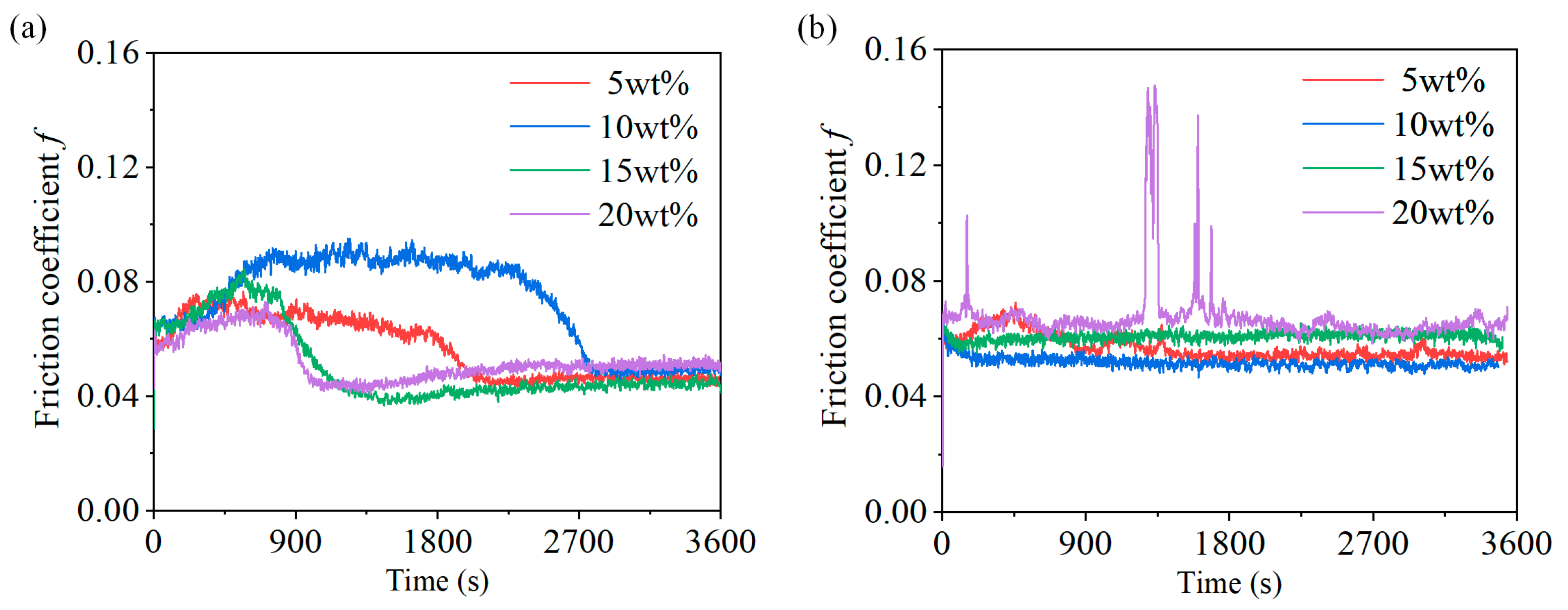
3.2.2. Abrasion Surface Topography of the Lower Specimen

3.2.3. Abrasion Trace Size of the Lower Specimen
- (1)
- For MoS2 nanolubricants, the abrasion trace size was smaller than that of the base fluid only when the additive percentage was 20 wt%. For the SiO2 nanolubricants, except for the abrasion trace at 5 wt% additive percentage, the size of the other abrasion traces was smaller than that of the base fluid. The abrasion trace size under the 15 wt% SiO2 nanolubricant was the lowest, with a width and a depth of 51.16% and 80.79% of the base fluid, respectively.
- (2)
- In general, a close relationship exists between the size and surface quality of the abrasion trace. A good surface quality means a small abrasion trace size. For experimental friction pairs, the SiO2 nanolubricant displayed a better anti-wear effect than the MoS2 nanolubricants. Whether the tribological performance is evaluated in terms of friction coefficient, abrasion surface quality, or abrasion trace size, the best results were obtained under the 10 wt% and 15 wt% of SiO2 nanolubricants.
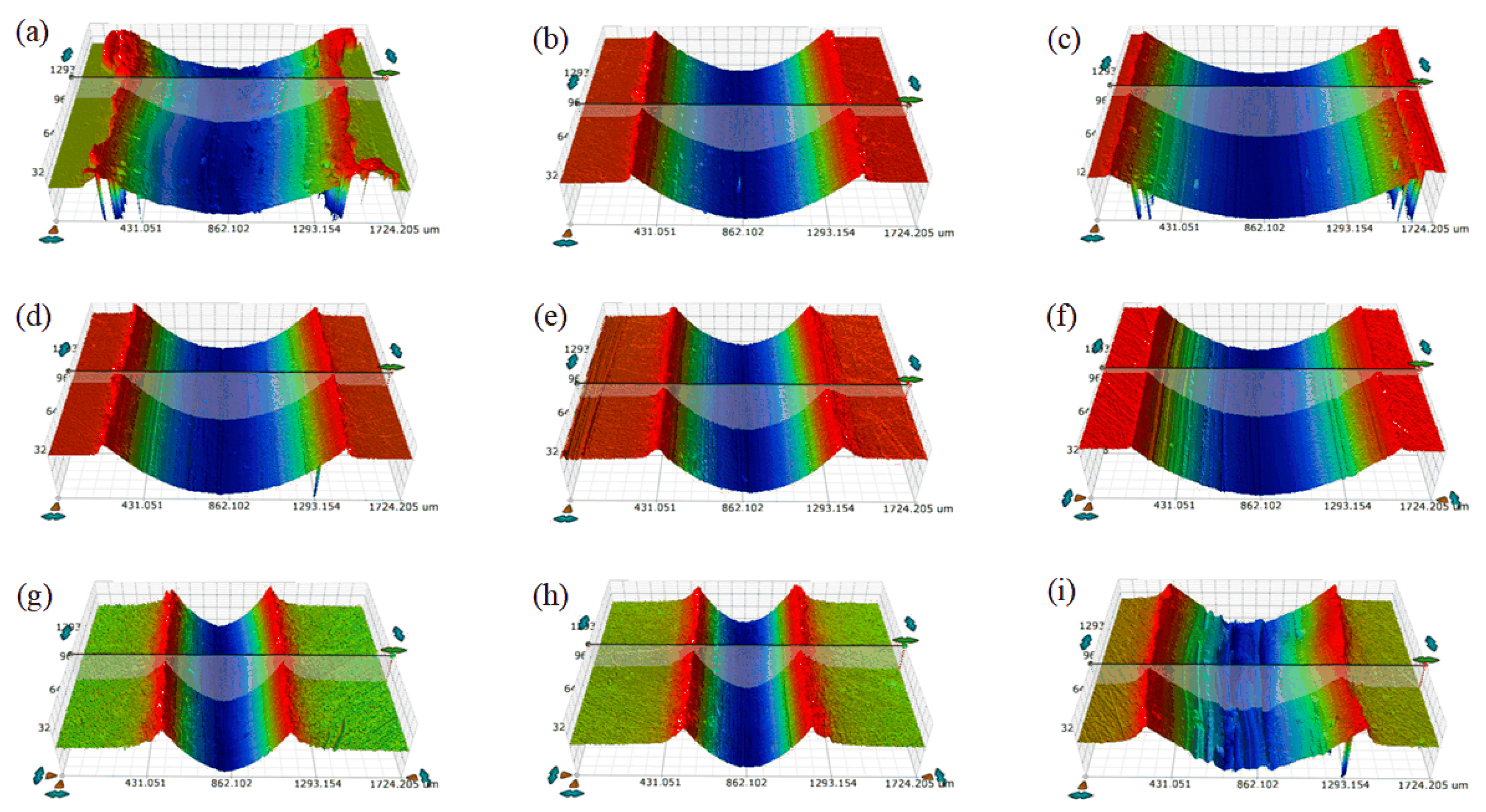
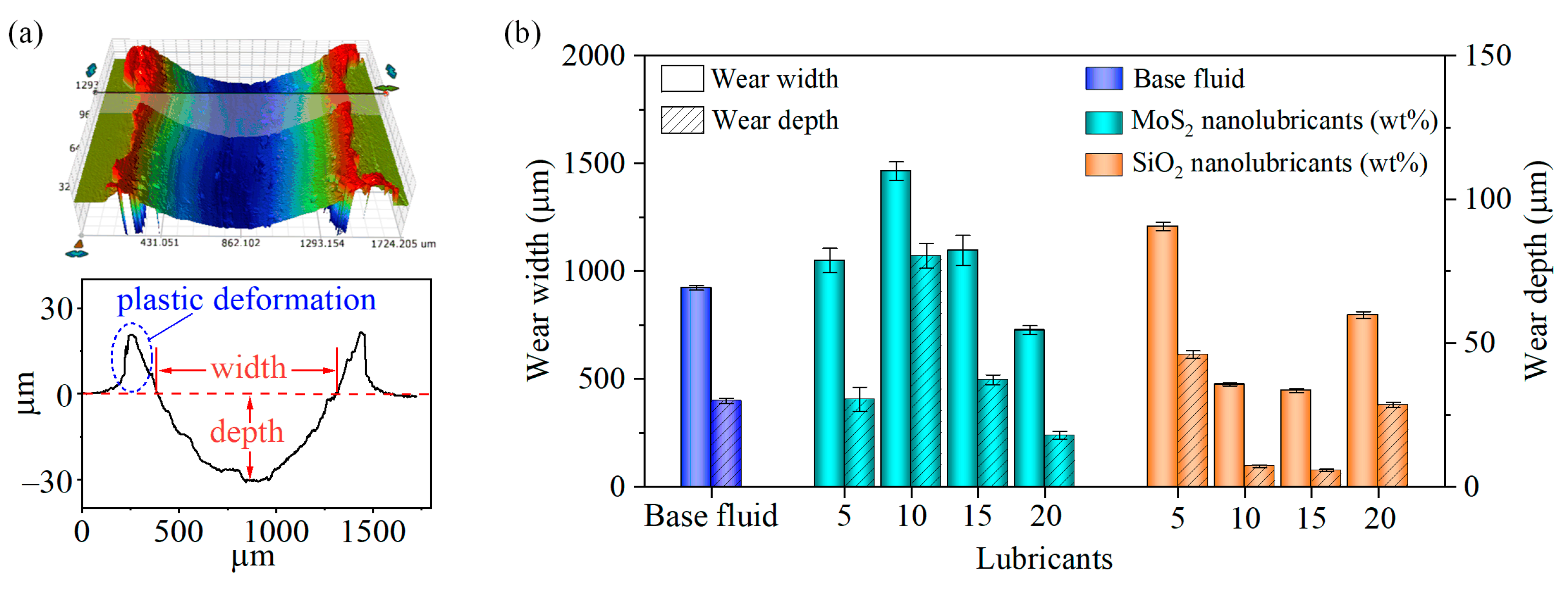
4. Analysis of Action Mechanism for Different Nano-Additives
- (1)
- According to Figure 16a,b, the Mo and Si contents on the original surface were 3.70% and 0.31%, while the contents on the abrasion surface under the base fluid were 3.53% and 0.52%, respectively. The difference between the two is very small.
- (2)
- Figure 16c,d show that, under the 5 wt% MoS2 nanolubricant, the Mo contents in the smooth area and severe wear area of the abrasion trace were 8.84% and 12.85%, respectively, which are much higher than the 3.53% under the base fluid, indicating increases of 5.31% and 9.32%, respectively. The significant increase in the Mo content in different areas means that a layer of MoS2 adsorption film formed on the abrasion surface. Meanwhile, the Mo content in the severe wear area is higher than that in the smooth area, indicating that a great amount of MoS2 additives was squeezed into the furrows or chipping pits on the abrasion surface, resulting in the mending effect.
- (3)
- According to Figure 16e,f, under the 5 wt% SiO2 nanolubricants, the Si contents in the smooth area and severe wear area of the abrasion trace were 0.90% and 3.03%, respectively, which are larger than 0.52% under the base fluid, indicating increases of only 0.38% and 2.51%, respectively. This result indicates that the adsorption film and mending effects of SiO2 additives are not obvious. Therefore, the improvement of the anti-friction performance of SiO2 nanolubricants should be mainly attributed to the rolling and polishing effects of hard SiO2 additives, which transform sliding friction into rolling friction between the friction pairs.
5. Conclusions
- (1)
- MoS2 and SiO2 nano-additives could improve the viscosity of mineral oil and change its wettability. And there was a certain correlation between the viscosity and wettability of nanolubricants. Due to the differences in physical properties of the two additives, the wettability of MoS2 and SiO2 nanolubricants exhibited different variation trends with their viscosity. The wettability of the MoS2 nanolubricants increased with the viscosity, while the wettability of the SiO2 nanolubricants decreased.
- (2)
- Although MoS2 and SiO2 nanolubricants had different change characteristics of friction coefficient with the frictional time, their maximum and fluctuation values were all smaller than those of base liquid. For MoS2 nanolubricant, when the additive percentage was 20 wt%, the friction coefficient curve fluctuated the least, and the maximum value was 0.073, which was much smaller than 0.178 of the base fluid. For the SiO2 nanolubricant, the best anti-friction effect was achieved when the additive percentage was 10 wt%, and the maximum friction coefficient was less than 0.06.
- (3)
- Compared with the base fluid, the nanolubricants can improve the surface quality of abrasion traces. However, the abrasion surfaces of the two nanolubricants had different topography characteristics. Furrow and material smearing were the two main topography features under the MoS2 nanolubricant. And, with the rise in MoS2 percentage, the effect of material smearing was enhanced, and the surface quality of the abrasion trace was improved. With the change in SiO2 percentage, the abrasion surface quality showed a trend of first improvement and then deterioration, and the surface quality with 10 wt% and 15 wt% SiO2 nanolubricant was better.
- (4)
- A close internal relationship exists between friction coefficient, abrasion surface quality, and abrasion trace size. A steady friction coefficient represents a good abrasion surface quality and a small abrasion trace size. For the experimental friction pairs, the SiO2 nanolubricant has a better anti-friction effect than MoS2 nanolubricants. With 10 wt% and 15 wt% SiO2 nanolubricants, the width and depth of abrasion traces were about half those of the base fluid.
- (5)
- The soft MoS2 nano-additive and the hard SiO2 nano-additive have different anti-friction mechanisms. The action mechanism of the MoS2 nano-additive is the adsorption film effect and mending effect of nanoparticles, while the main action mechanism of the SiO2 nano-additive should be the polishing effect and rolling effect of nanoparticles.
Author Contributions
Funding
Data Availability Statement
Conflicts of Interest
References
- Holmberg, K.; Erdemir, A. Influence of tribology on global energy consumption, costs and emissions. Friction 2017, 5, 263–284. [Google Scholar] [CrossRef]
- Brinksmeier, E.; Meyer, D.; Huesmann-Cordes, A.G.; Herrmann, C. Metalworking fluids—Mechanisms and performance. CIRP Annals. 2015, 64, 605–628. [Google Scholar] [CrossRef]
- Öndin, O.; Kıvak, T.; Sarıkaya, M.; Yıldırım, Ç.V. Investigation of the influence of MWCNTs mixed nanofluid on the machinability characteristics of PH 13-8 Mo stainless steel. Tribol. Int. 2020, 148, 106323. [Google Scholar] [CrossRef]
- Shariatmadar, F.S.; Pakdehi, S.G. Synthesis and characterization of aviation turbine kerosene nanofluid fuel containing boron nanoparticles. Energy Fuels. 2016, 30, 7755–7762. [Google Scholar] [CrossRef]
- Wang, X.; Li, C.; Zhang, Y.; Ali, H.M.; Sharma, S.; Li, R.; Yang, M.; Said, Z.; Liu, X. Tribology of enhanced turning using biolubricants: A comparative assessment. Tribol. Int. 2022, 174, 107766. [Google Scholar] [CrossRef]
- Saidur, R.; Kazi, S.N.; Hossain, M.S.; Rahman, M.M.; Mohammed, H.A. A review on the performance of nanoparticles suspended with refrigerants and lubricating oils in refrigeration systems. Renew. Sustain. Energy Rev. 2011, 15, 310–323. [Google Scholar] [CrossRef]
- Kotia, A.; Rajkhowa, P.; Rao, G.S.; Ghosh, S.K. Thermophysical and tribological properties of nanolubricants: A review. Heat Mass Transf. 2018, 54, 3493–3508. [Google Scholar] [CrossRef]
- Dai, W.; Kheireddin, B.; Gao, H.; Liang, H. Roles of nanoparticles in oil lubrication. Tribol. Int. 2016, 102, 88–98. [Google Scholar] [CrossRef]
- Wang, B.; Qiu, F.; Barber, G.C.; Zou, Q.; Wang, J.; Guo, S.; Yuan, Y.; Jiang, Q. Role of nano-sized materials as lubricant additives in friction and wear reduction: A review. Wear 2022, 490, 204206. [Google Scholar] [CrossRef]
- Jatti, V.S.; Singh, T.P. Copper oxide nano-particles as friction-reduction and anti-wear additives in lubricating oil. J. Mech. Sci. Technol. 2015, 29, 793–798. [Google Scholar] [CrossRef]
- Sia, S.Y.; Sarhan, A.A.D. Morphology investigation of worn bearing surfaces using SiO2 nanolubrication system. Int. J. Adv. Manuf. Technol. 2014, 70, 1063–1071. [Google Scholar] [CrossRef]
- Sujan, K.; Wang, B.; Hu, M.; Meng, S.; Zhang, L.; Hu, R.; Barber, G.C. Tribological properties of Al2O3/WS2 oil-based composite lubricant utilized on steel-brass frictional couples. Surf. Topogr. Metrol. Prop. 2021, 9, 015018. [Google Scholar] [CrossRef]
- Su, Y.; Gong, L.; Chen, D. An investigation on tribological properties and lubrication mechanism of graphite nanoparticles as vegetable based oil additive. J. Nanomater. 2015, 2015, 276753. [Google Scholar] [CrossRef]
- Yu, R.; Liu, J.; Zhou, Y. Experimental study on tribological property of MoS2 nanoparticle in castor oil. J. Tribol. 2019, 141, 102001. [Google Scholar] [CrossRef]
- Mo, Y.H.; Tao, D.H.; Wei, X.C. Activation and self-repairing effectiveness of lubrication with nano-tin as additives. J. Shanghai Univ. Engl. Ed. 2009, 13, 45–50. [Google Scholar] [CrossRef]
- Singh, Y.; Singh, N.K.; Sharma, A. Effect of SiO2 nanoparticles on the tribological behavior of Balanites Aegytiaca (Desert date) oil-based biolubricant. J. Bio Tribo-corros. 2021, 7, 1–6. [Google Scholar] [CrossRef]
- Chu, H.Y.; Hsu, W.C.; Lin, J.F. The anti-scuffing performance of diamond nano-particles as an oil additive. Wear 2010, 268, 960–967. [Google Scholar] [CrossRef]
- Gupta, M.K.; Bijwe, J. A complex interdependence of dispersant in nano-suspensions with varying amount of graphite particles on its stability and tribological performance. Tribol. Int. 2020, 142, 105968. [Google Scholar] [CrossRef]
- Luo, T.; Wei, X.; Huang, X.; Huang, L.; Yang, F. Tribological properties of Al2O3 nanoparticles as lubricating oil additives. Ceram. Int. 2014, 40, 7143–7149. [Google Scholar] [CrossRef]
- Peyghambarzadeh, S.M.; Hashemabadi, S.H.; Jamnani, M.S.; Hoseini, S.M. Improving the cooling performance of automobile radiator with Al2O3/water nanofluid. App. Therm. Eng. 2011, 31, 1833–1838. [Google Scholar] [CrossRef]
- Mohamed, K.A.A.; Hou, X.J.; Abdelkareem, M.A.A. Anti-wear properties evaluation of frictional sliding interfaces in automobile engines lubricated by copper/graphene nanolubricants. Friction 2020, 8, 905–916. [Google Scholar]
- Kulkarni, D.P.; Vajjha, R.S.; Das, D.K.; Oliva, D. Application of aluminum oxide nanofluids in diesel electric generator as jacket water coolant. App. Therm. Eng. 2008, 28, 1774–1781. [Google Scholar] [CrossRef]
- Buongiorno, J.; Hu, L.W.; Kim, S.J.; Hannink, R.; Truong, B.A.O.; Forrest, E. Nanofluids for enhanced economics and safety of nuclear reactors: An evaluation of the potential features, issues, and research gaps. Nucl. Technol. 2008, 162, 80–91. [Google Scholar] [CrossRef]
- Syafiq, A.M.; Redhwan, A.A.M.; Hazim, A.A.; Aminullah, A.R.M.; Ariffin, S.Z.; Nughoro, W.; Arifuddin, A.; Hawa, A.B.S. An Experimental Evaluation of SiO2 nano cutting fluids in CNC Turning of Aluminium Alloy AL319 via MQL Technique. IOP Conf. Ser. Mater. Sci. Eng. 2021, 1068, 012009. [Google Scholar] [CrossRef]
- Ni, J.; Cui, Z.; He, L.; Yang, Y.; Sang, Z.; Rahman, M.M. Reinforced lubrication of vegetable oils with nano-particle additives in broaching. J. Manuf. Process. 2021, 70, 518–528. [Google Scholar] [CrossRef]
- Pal, A.; Chatha, S.S.; Sidhu, H.S. Performance evaluation of the minimum quantity lubrication with Al2O3-mixed vegetable-oil-based cutting fluid in drilling of AISI 321 stainless steel. J. Manuf. Process. 2021, 66, 238–249. [Google Scholar] [CrossRef]
- Gajrani, K.K.; Ram, D.; Sankar, M.R. Biodegradation and hard machining performance comparison of eco-friendly cutting fluid and mineral oil using flood cooling and minimum quantity cutting fluid techniques. J. Clean. Prod. 2017, 165, 1420–1435. [Google Scholar] [CrossRef]
- Okokpujie, I.P.; Tartibu, L.K. Experimental analysis of cutting force during machining difficult to cut materials under dry, mineral oil, and TiO2 nano-lubricant. J. Meas. Eng. 2021, 9, 218–230. [Google Scholar] [CrossRef]
- Harsha, A.P.; Khatri, O.P. The Effect of Spherical Hybrid Silica-Molybdenum Disulfide on the Lubricating Characteristics of Castor Oil. J. Tribol. 2023, 145, 121701-1. [Google Scholar]
- Prasad, B.K.; Rathod, S.; Yadav, M.S.; Modi, O.P. Effects of some solid lubricants suspended in oil toward controlling the wear performance of a cast iron. J. Tribol. 2010, 132, 041602. [Google Scholar] [CrossRef]
- Yegin, C.; Lu, W.; Kheireddin, B.; Zhang, M.; Li, P.; Min, Y.; Sue, H.J.; Sari, M.M.; Akbulut, M. The effect of nanoparticle functionalization on lubrication performance of nanofluids dispersing silica nanoparticles in an ionic liquid. J. Tribol. 2017, 139, 041802. [Google Scholar] [CrossRef]
- Basso, C.R.; Crulhas, B.P.; Castro, G.R.; Pedrosa, V.A. A study of the effects of pH and surfactant addition on gold nanoparticle aggregation. J. Nanosci. Nanotechnol. 2020, 20, 5458–5468. [Google Scholar] [CrossRef] [PubMed]
- Bao, L.; Zhong, C.; Jie, P.; Hou, Y. The effect of nanoparticle size and nanoparticle aggregation on the flow characteristics of nanofluids by molecular dynamics simulation. Adv. Mech. Eng. 2019, 11, 1–17. [Google Scholar] [CrossRef]
- Xu, M.H.; Cao, Y.Y.; Gao, S.G. Surface modification of nano-silica with silane coupling agent. Key Eng. Mater. 2015, 636, 23–27. [Google Scholar] [CrossRef]
- Hou, X.; Jiang, H.; Ali, M.K.A.; Liu, H.; Su, D.; Tian, Z. Dispersion behavior assessment of the molybdenum disulfide nanomaterials dispersed into poly alphaolefin. J. Mol. Liq. 2020, 311, 113303. [Google Scholar] [CrossRef]
- Harigaya, Y.; Suzuki, M.; Toda, F.; Takiguchi, M. Analysis of oil film thickness and heat transfer on a piston ring of a diesel engine: Effect of lubricant viscosity. J. Eng. Gas Turbines Power 2006, 128, 685–693. [Google Scholar] [CrossRef]
- Singh, J.; Kumar, D.; Tandon, N. Development of nanocomposite grease: Microstructure, flow, and tribological studies. J. Tribol. 2017, 139, 052001. [Google Scholar]
- Parizad, A.; Shahbazi, K.; Tanha, A.A. SiO2 nanoparticle and KCl salt effects on filtration and thixotropical behavior of polymeric waterbased drilling fluid: With zeta potential and size analysis. Results Phys. 2018, 9, 1656–1665. [Google Scholar] [CrossRef]
- Sanukrishna, S.S.; Vishnu, S.; Prakash, M.J. Experimental investigation on thermal and rheological behaviour of PAG lubricant modified with SiO2 nanoparticles. J. Mol. Liq. 2018, 261, 411–422. [Google Scholar] [CrossRef]
- Basha, M.M.; Sankar, M.R. Experimental tribological study on additive manufactured Inconel 718 features against the hard carbide counter bodies. J. Tribol. 2023, 145, 121702. [Google Scholar]
- Sajeeb, A.; Krishnan Rajendrakumar, P. Experimental studies on viscosity and tribological characteristics of blends of vegetable oils with CuO nanoparticles as additive. Micro Nano Lett. 2019, 14, 1121–1125. [Google Scholar] [CrossRef]
- Jason, Y.J.J.; How, H.G.; Teoh, Y.H.; Chuah, H.G. A study on the tribological performance of nanolubricants. Processes 2020, 8, 1372. [Google Scholar] [CrossRef]
- Cui, X.; Li, C.; Ding, W.F.; Chen, Y.; Mao, C.; Xu, X.F.; Liu, B.; Wang, D.Z.; Li, H.N.; Zhang, Y.B.; et al. Minimum quantity lubrication machining of aeronautical materials using carbon group nanolubricant: From mechanisms to application. Chin. J. Aeronaut. 2022, 35, 85–112. [Google Scholar] [CrossRef]


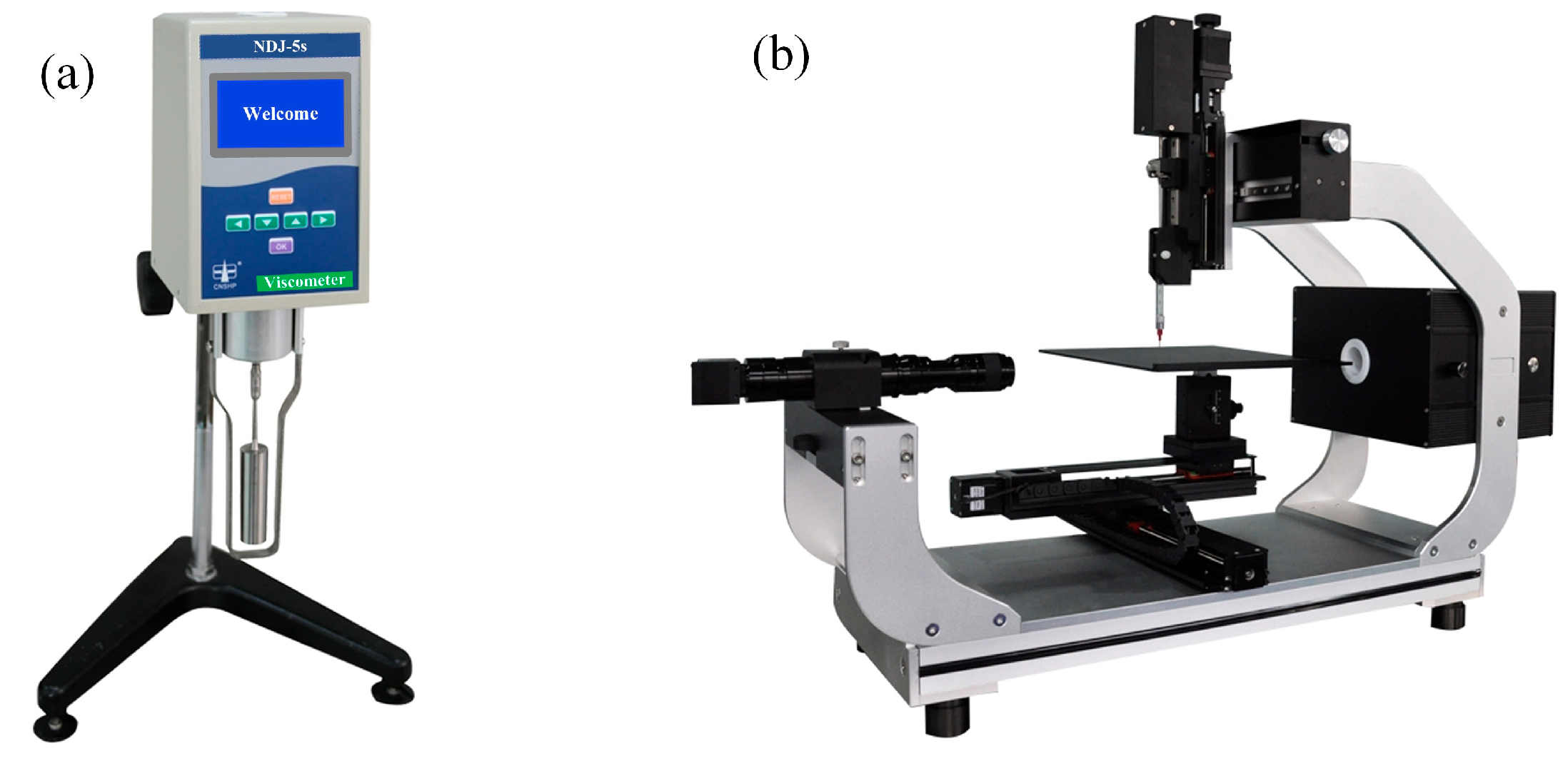
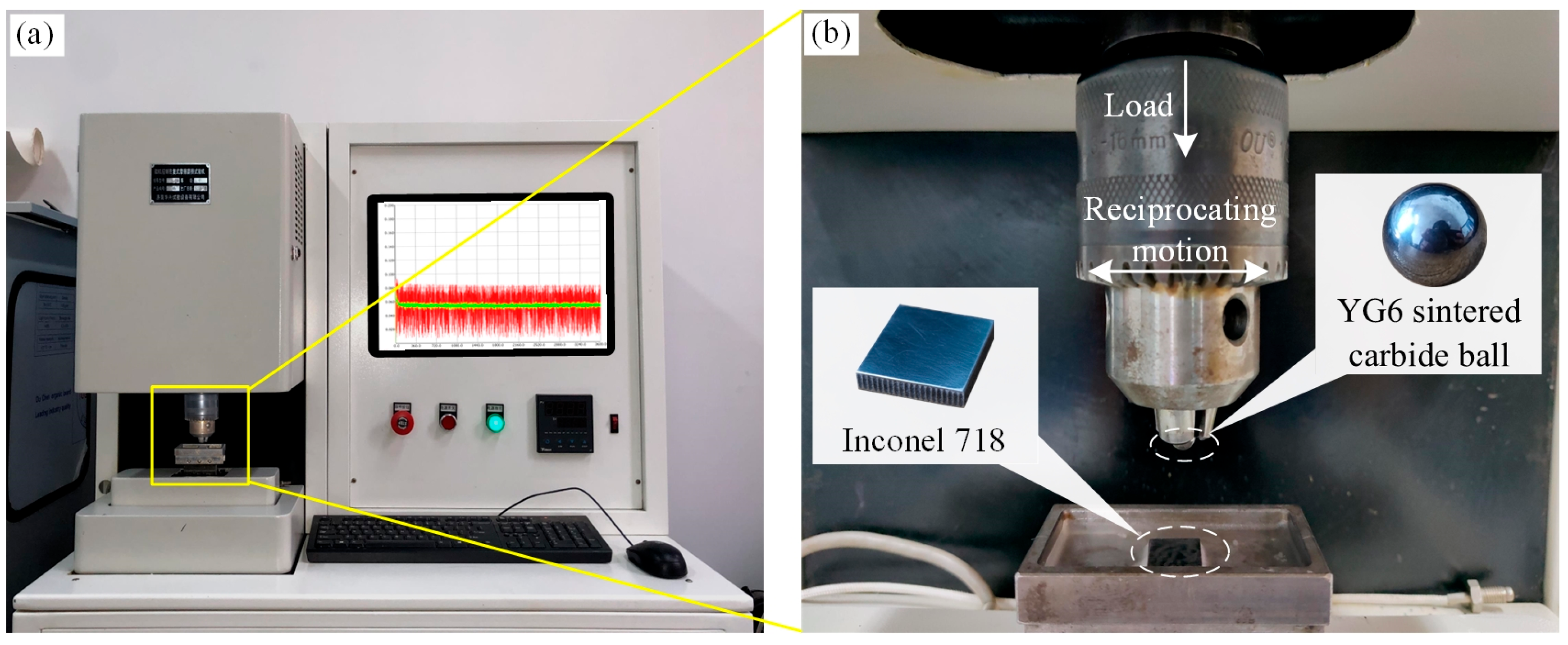

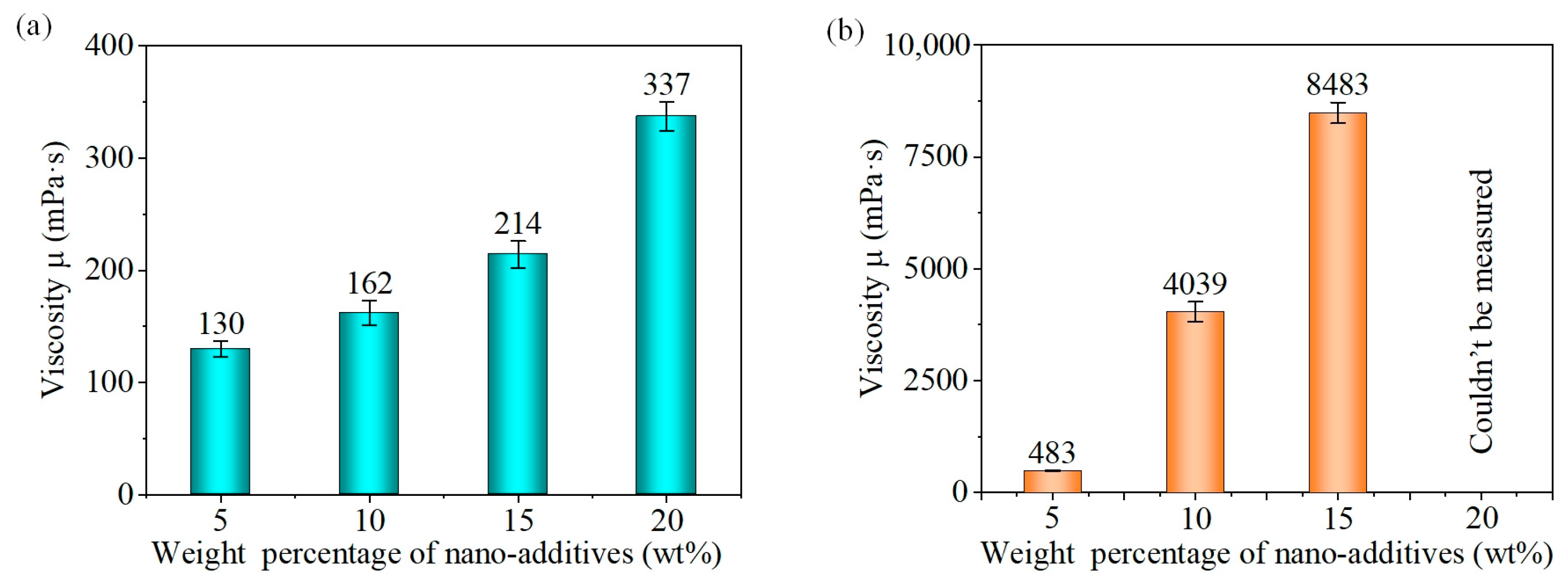



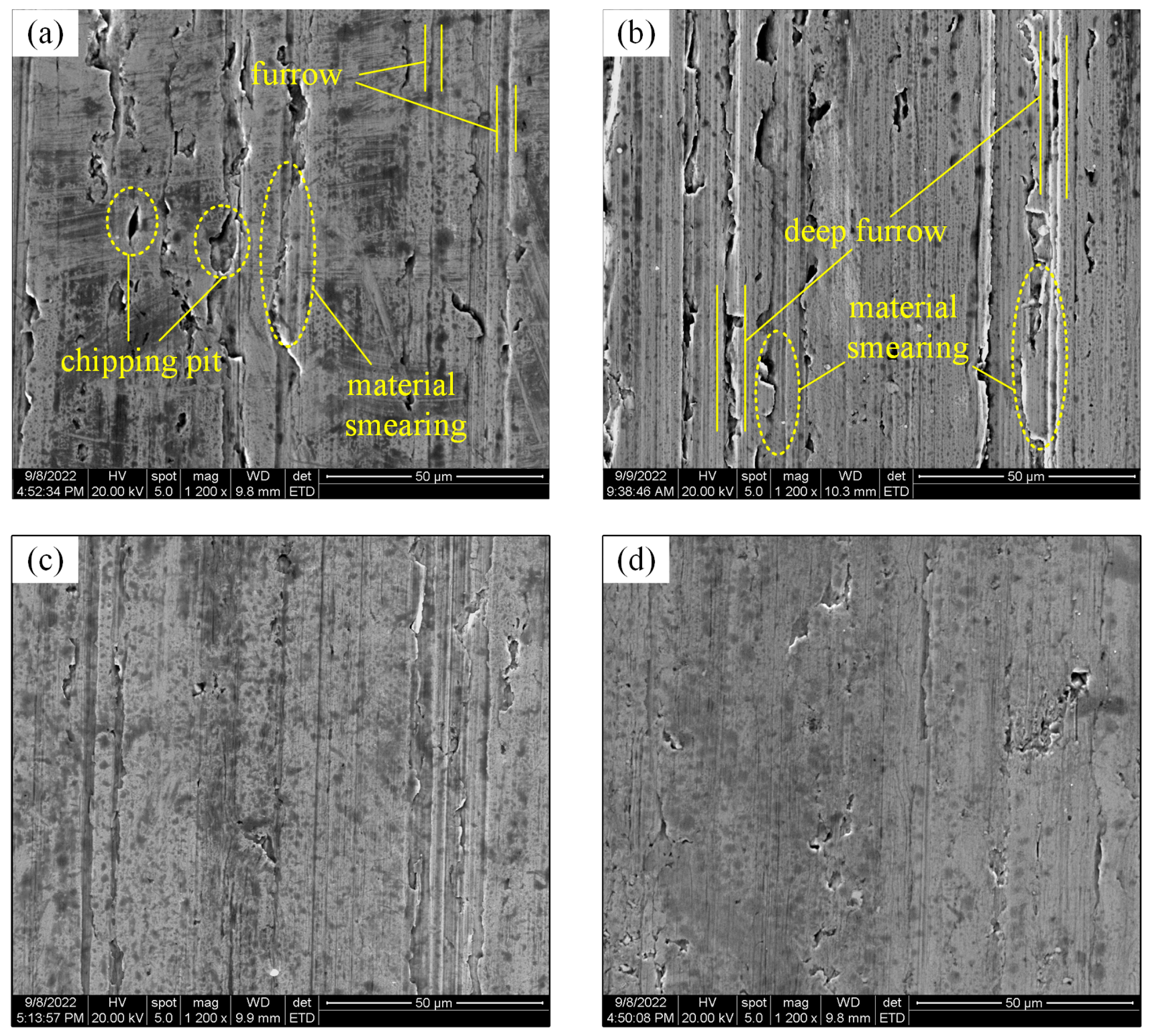
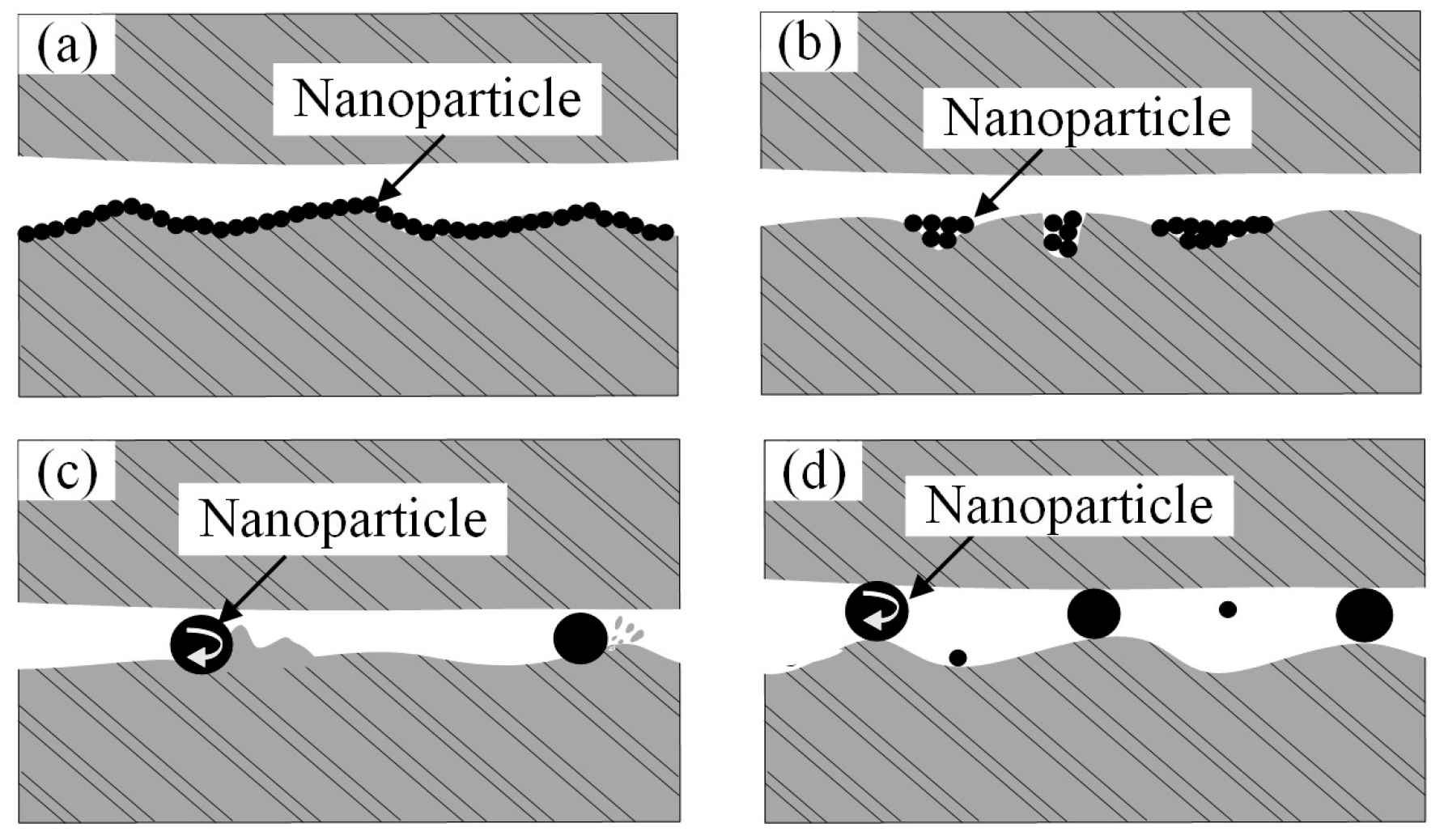
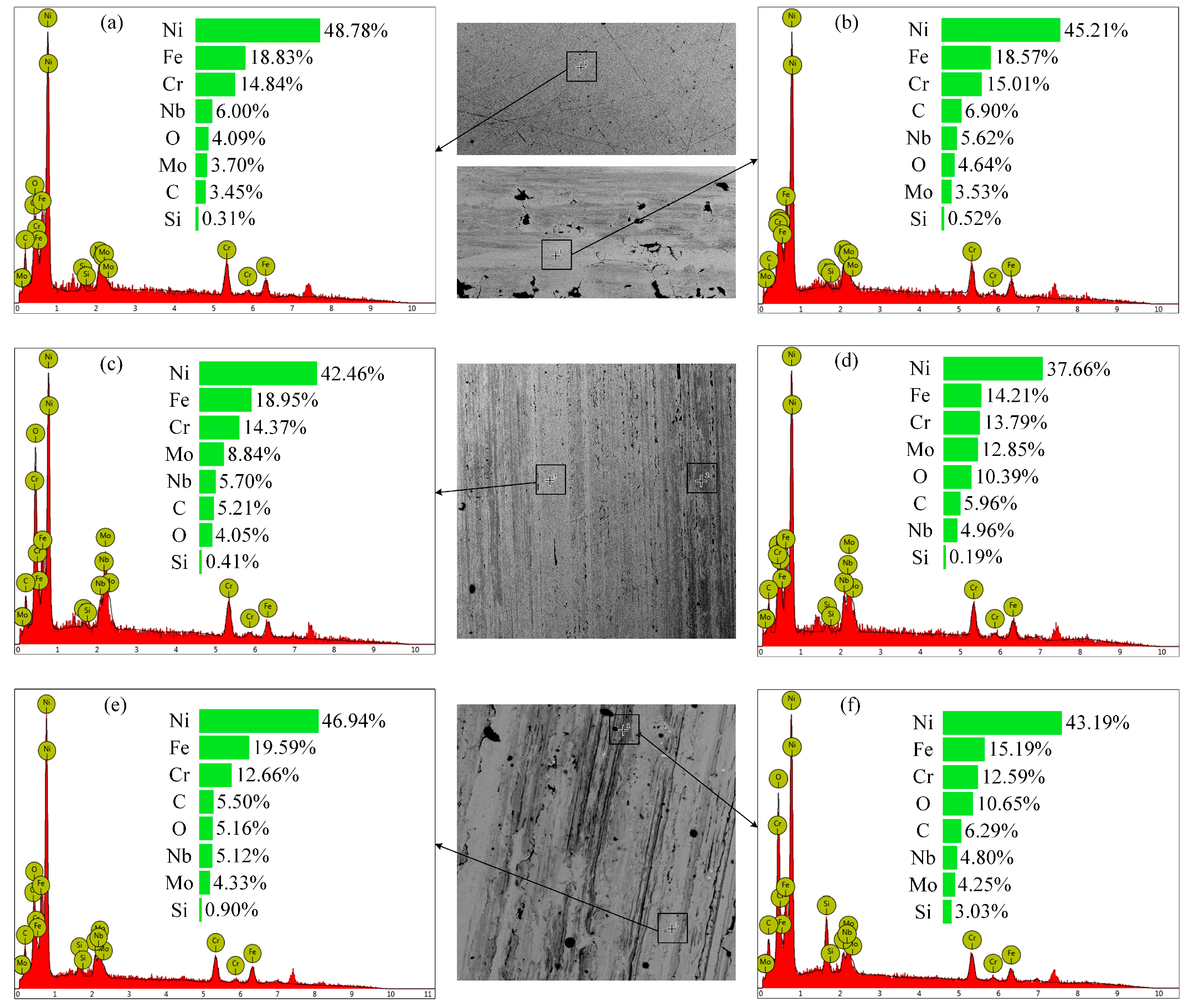
| Nanoparticle | Molecular Weight | Density (g/cm3) | Melting Point (°C) | Moh’s Hardness |
|---|---|---|---|---|
| SiO2 | 60.08 | 2.2–2.6 | 1723 | 7 |
| MoS2 | 160.07 | 4.8 | 2375 | 1.0–1.5 |
| Indexes | Density | Kinematic Viscosity (40 °C) (mm2/s) | Flash Point (°C) | Pour Point (°C) |
|---|---|---|---|---|
| Value | 0.87 | 62–68 | 238 | −12 |
| Chemical Element | Ni | Cr | Nb | Mo | Ti | Al | Co | C | Mn | Si | P | S | B | Cu | Fe |
|---|---|---|---|---|---|---|---|---|---|---|---|---|---|---|---|
| Minimum value | 50.0 | 17.0 | 4.75 | 2.8 | 0.65 | 0.2 | — | — | — | — | — | — | — | — | Margin |
| Maximum value | 55.0 | 21.0 | 5.50 | 3.3 | 1.15 | 0.8 | 1.0 | 0.08 | 0.35 | 0.35 | 0.015 | 0.015 | 0.006 | 0.3 |
| Yield Strength | Tensile Strength | Elongation | Poisson Ratio | Thermal Conductivity | Density | Hardness |
|---|---|---|---|---|---|---|
| MPa | MPa | % | GPa | W/m·K | g/cm3 | HV |
| 1110 | 1310 | 23.3 | 206 | 11.2 | 8.47 | 281 |
| Co Content | WC Content | Flexure Strength | Impact Toughness | Poisson Ratio | Hardness | Density |
|---|---|---|---|---|---|---|
| % | % | MPa | J/cm | GPa | HRA | g/cm3 |
| 6 | 94 | 145 | 2.6 | 530 | 89.5 | 14.6–15.0 |
Disclaimer/Publisher’s Note: The statements, opinions and data contained in all publications are solely those of the individual author(s) and contributor(s) and not of MDPI and/or the editor(s). MDPI and/or the editor(s) disclaim responsibility for any injury to people or property resulting from any ideas, methods, instructions or products referred to in the content. |
© 2024 by the authors. Licensee MDPI, Basel, Switzerland. This article is an open access article distributed under the terms and conditions of the Creative Commons Attribution (CC BY) license (https://creativecommons.org/licenses/by/4.0/).
Share and Cite
Ma, L.; Li, F.; Ba, S.; Ma, Z.; Mao, X.; Feng, Q.; Yang, K. Investigation of Anti-Friction Properties of MoS2 and SiO2 Nanolubricants Based on the Friction Pairs of Inconel 718 Superalloy and YG6 Carbide. Lubricants 2025, 13, 4. https://doi.org/10.3390/lubricants13010004
Ma L, Li F, Ba S, Ma Z, Mao X, Feng Q, Yang K. Investigation of Anti-Friction Properties of MoS2 and SiO2 Nanolubricants Based on the Friction Pairs of Inconel 718 Superalloy and YG6 Carbide. Lubricants. 2025; 13(1):4. https://doi.org/10.3390/lubricants13010004
Chicago/Turabian StyleMa, Lijie, Fengnan Li, Shijie Ba, Zunyan Ma, Xinhui Mao, Qigao Feng, and Kang Yang. 2025. "Investigation of Anti-Friction Properties of MoS2 and SiO2 Nanolubricants Based on the Friction Pairs of Inconel 718 Superalloy and YG6 Carbide" Lubricants 13, no. 1: 4. https://doi.org/10.3390/lubricants13010004
APA StyleMa, L., Li, F., Ba, S., Ma, Z., Mao, X., Feng, Q., & Yang, K. (2025). Investigation of Anti-Friction Properties of MoS2 and SiO2 Nanolubricants Based on the Friction Pairs of Inconel 718 Superalloy and YG6 Carbide. Lubricants, 13(1), 4. https://doi.org/10.3390/lubricants13010004





